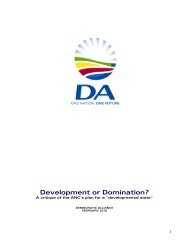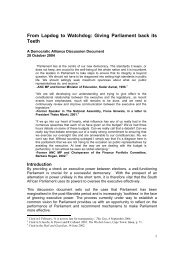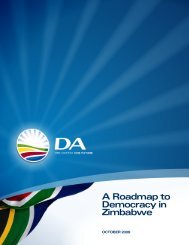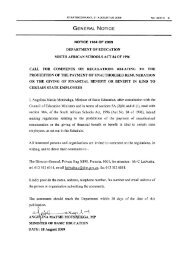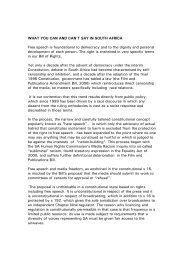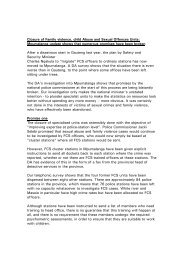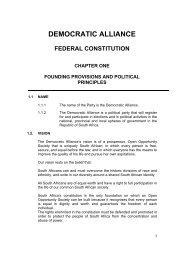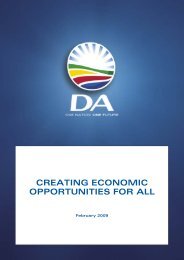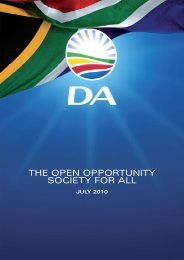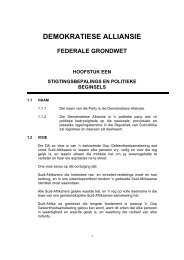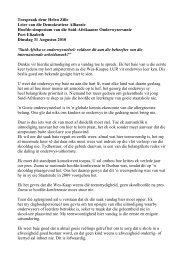DA's Plan for Growth and Jobs - Democratic Alliance
DA's Plan for Growth and Jobs - Democratic Alliance
DA's Plan for Growth and Jobs - Democratic Alliance
Create successful ePaper yourself
Turn your PDF publications into a flip-book with our unique Google optimized e-Paper software.
operative government’. The separation of powers between the executive, legislative <strong>and</strong>judicial arms of government was institutionalised.A collection of independent institutions - including the Public Prospector, Auditor General,<strong>and</strong> Human Rights, Gender <strong>and</strong> Electoral commissions – were established in terms ofChapter 9 of the Constitution, to guard against abuses of power <strong>and</strong> protect the rights ofindividual citizens.Progress was also made toward improving the quality of life <strong>for</strong> many of the poorest SouthAfricans. Through the Reconstruction <strong>and</strong> Development Programme (RDP), the governmentrolled out a comprehensive plan to exp<strong>and</strong> access to basic amenities such as housing,water, sanitation, schooling, primary healthcare <strong>and</strong> electricity to communities that had beendenied these in the past.The programme can claim many success stories.For the first time in our history, South Africa has a comprehensive social security systemwhich serves all citizens in need, regardless of race. It features an extensive array of grantsthat provide assistance to senior citizens, the disabled, children in need, foster parents, <strong>and</strong>many others too poor to meet their basic social requirements. Millions of people’s lives havebeen changed <strong>for</strong> the better as a consequence of free healthcare programmes <strong>and</strong> freemeals at schools.However, shortly after its initial implementation, the RDP began to encounter problems.Economic challenges post-1994It became very clear very quickly that the government did not have the capacity to fullyimplement the RDP. A severe shortage of professional <strong>and</strong> project management skills in thepublic sector, coupled with inadequate resources <strong>and</strong> poor administration, resulted in everincreasingbacklogs. The new provincial administrations, only recently established, were in astate of flux, making them unreliable implementing partners.Promises soon outstripped outcomes, <strong>and</strong> a new phrase began to enter the public lexicon:service delivery failure.It also became apparent that the state did not have the money to fund the RDP’s manyinitiatives. The new government had hoped that the transition to democracy, <strong>and</strong> SouthAfrica’s welcome reception into the international community, would bring with it improvedeconomic integration, better international trade ties, much-needed <strong>for</strong>eign direct investment(FDI), <strong>and</strong> healthy GDP growth.This did not happen. Economic growth idled at 2.5%, far from the targeted 4-6%. The budgetdeficit stood at 4.3% <strong>and</strong> government debt rose to 50% of GDP. The then-Deputy PresidentThabo Mbeki, <strong>and</strong> the Finance Minister at the time, Trevor Manuel, understood that if thissituation was allowed to continue it would curtail the government’s policy options <strong>and</strong>severely limit the economy’s capacity to create opportunities <strong>for</strong> people in the long term.It became apparent that with the RDP programme, which presented a large scale fiscalspending programme aimed at improving the life of South Africa’s poorest citizens, the ANChad neglected to create a productive economic policy that would ensure the af<strong>for</strong>dability <strong>and</strong>sustainability of RDP expenditure. As a result, whilst some indicators of basic servicesimproved, poverty rates in South Africa remained broadly unchanged.21 | P a g e



